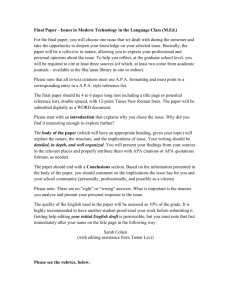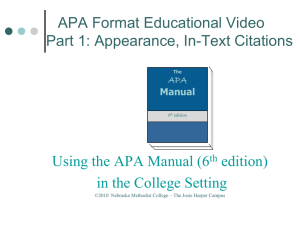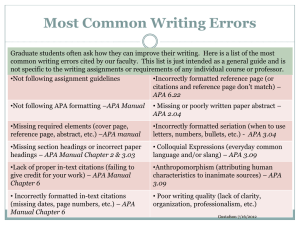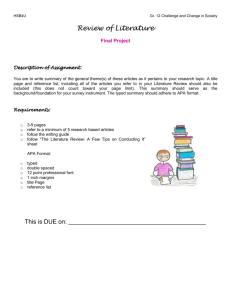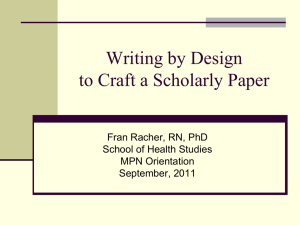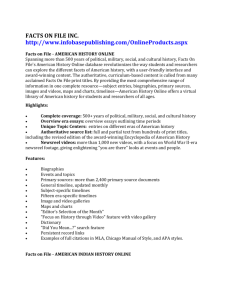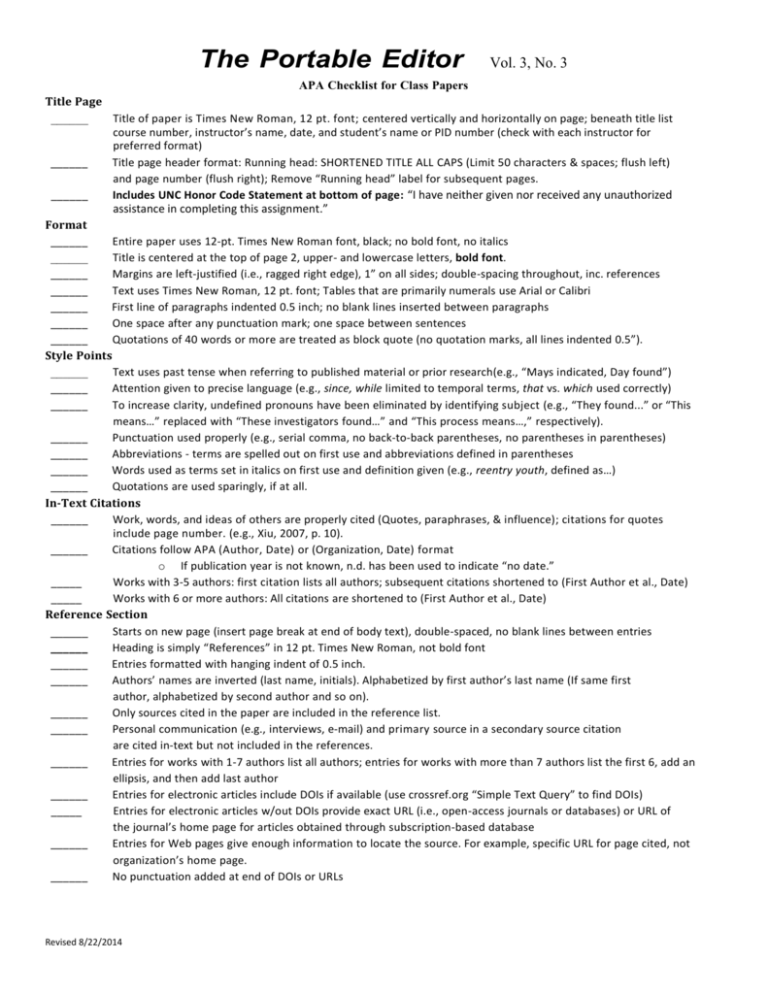
The Portable Editor
Vol. 3, No. 3
APA Checklist for Class Papers
Title Page
______
Title of paper is Times New Roman, 12 pt. font; centered vertically and horizontally on page; beneath title list
course number, instructor’s name, date, and student’s name or PID number (check with each instructor for
preferred format)
______
Title page header format: Running head: SHORTENED TITLE ALL CAPS (Limit 50 characters & spaces; flush left)
and page number (flush right); Remove “Running head” label for subsequent pages.
______
Includes UNC Honor Code Statement at bottom of page: “I have neither given nor received any unauthorized
assistance in completing this assignment.”
Format
______
Entire paper uses 12-pt. Times New Roman font, black; no bold font, no italics
______
Title is centered at the top of page 2, upper- and lowercase letters, bold font.
______
Margins are left-justified (i.e., ragged right edge), 1” on all sides; double-spacing throughout, inc. references
______
Text uses Times New Roman, 12 pt. font; Tables that are primarily numerals use Arial or Calibri
______
First line of paragraphs indented 0.5 inch; no blank lines inserted between paragraphs
______
One space after any punctuation mark; one space between sentences
______
Quotations of 40 words or more are treated as block quote (no quotation marks, all lines indented 0.5”).
Style Points
______
Text uses past tense when referring to published material or prior research(e.g., “Mays indicated, Day found”)
______
Attention given to precise language (e.g., since, while limited to temporal terms, that vs. which used correctly)
______
To increase clarity, undefined pronouns have been eliminated by identifying subject (e.g., “They found...” or “This
means…” replaced with “These investigators found…” and “This process means…,” respectively).
______
Punctuation used properly (e.g., serial comma, no back-to-back parentheses, no parentheses in parentheses)
______
Abbreviations - terms are spelled out on first use and abbreviations defined in parentheses
______
Words used as terms set in italics on first use and definition given (e.g., reentry youth, defined as…)
______
Quotations are used sparingly, if at all.
In-Text Citations
______
Work, words, and ideas of others are properly cited (Quotes, paraphrases, & influence); citations for quotes
include page number. (e.g., Xiu, 2007, p. 10).
______
Citations follow APA (Author, Date) or (Organization, Date) format
o If publication year is not known, n.d. has been used to indicate “no date.”
_____
Works with 3-5 authors: first citation lists all authors; subsequent citations shortened to (First Author et al., Date)
_____
Works with 6 or more authors: All citations are shortened to (First Author et al., Date)
Reference Section
______
Starts on new page (insert page break at end of body text), double-spaced, no blank lines between entries
______
Heading is simply “References” in 12 pt. Times New Roman, not bold font
______
Entries formatted with hanging indent of 0.5 inch.
______
Authors’ names are inverted (last name, initials). Alphabetized by first author’s last name (If same first
author, alphabetized by second author and so on).
______
Only sources cited in the paper are included in the reference list.
______
Personal communication (e.g., interviews, e-mail) and primary source in a secondary source citation
are cited in-text but not included in the references.
______
Entries for works with 1-7 authors list all authors; entries for works with more than 7 authors list the first 6, add an
ellipsis, and then add last author
______
Entries for electronic articles include DOIs if available (use crossref.org “Simple Text Query” to find DOIs)
_____
Entries for electronic articles w/out DOIs provide exact URL (i.e., open-access journals or databases) or URL of
the journal’s home page for articles obtained through subscription-based database
______
Entries for Web pages give enough information to locate the source. For example, specific URL for page cited, not
organization’s home page.
______
No punctuation added at end of DOIs or URLs
Revised 8/22/2014
Writing Support Available to SSW Students
Writing Resources Page on the School’s website: http://ssw.unc.edu/students
Under the Current Students tab. Includes archives of Portable Editor tip sheets, library of PowerPoint
presentations, and links to other resources.
APA Quick Reference Guide – download from the Writing Resources page
Grammar Review and Tutorial on Sakai – SOWO Grammar Skills SP10 – send an e-mail to Tiffany Carver at
tscarver@email.unc.edu with “Sign me up for Grammar Skills” in subject line
Writing Support Team: SOSWwritingsupport@gmail.com
The School’s Team offers face-to-face appointments, quick answers via e-mail, or support via a
combination of phone and e-mail.
When requesting an appointment, please include 2-3 “best times” (i.e., specific dates and times) that
work for your schedule. A team member will honor your request, if possible. Having several time slots
to choose from avoids a lot of back-and-forth e-mail to find a mutually agreeable date and time.
The Portable Editor is a monthly in-house e-mail newsletter written by Susan White and Diane Wyant to help
students, faculty, and staff improve their writing skills. The Portable Editor is sent only to those who have asked
to be included on the LISTSERV. To subscribe, send an e-mail with “Subscribe to Portable Editor Listserv” in the
subject line to Susan White at sewhite@email.unc.edu
UNC Writing Center – Student and Academic Services Building, North
On-campus graduate students can use the Center once per week. The Writing Center offers 50-minute face-to-face
sessions and an online tutoring system.
APA Citation Guide for Online Sources: http://www.lcc.edu/library/help/citation/apaonline.aspx
o Lansing Community College – one of millions, but this site links examples to page in APA Manual.
Self-paced tutorial for APA style: http://www.lib.unc.edu/instruct/citations/?page=apa_sample
Other Resources:
Duke Graduate School Writing Resource Center. (2013). Scientific writing resource. Retrieved from
https://cgi.duke.edu/web/sciwriting/index.php
Three online lessons that can be completed in about 45 minutes. Lessons address effective sentence and
paragraph structure, cohesion, concision, and clarity.
Hacker, D. (2003). A writer’s reference (5th ed.). New York, NY: Bedford/St. Martin.
Provides clear and useful explanations of proper use of punctuation and grammar. Often used as textbook, so
used copies can usually be found for $1- $5. Diane Wyant has several copies to lend.
Gopen, G. D., & Swan, J. A. (1990). The science of scientific writing. American Scientist, 78, 550-558. Retrieved from
http://www.americanscientist.org/issues/feature/the-science-of-scientific-writing/1
Brief introduction to improving communication by writing from the reader’s perspective.
Alley, M. (1996). The craft of scientific writing (3rd ed.). New York, NY: Springer.
Williams, J. M. (2005). Style: Ten lessons in clarity and grace (8th ed.). New York, NY: Pearson Longman.
Invaluable practical tips for improving flow and clarity in writing. Used copies abound.
American Psychological Association. (2010). Publication manual of the American Psychological Association (6th
ed.).Washington, DC: Author
If buying used, make sure you get second or later printing (August 2009 or later). First printing (July 2009)
had so many errors it was “quietly” recalled.
Supplement to the APA Manual: APA Style Blog at http://blog.apastyle.org/
Blog has searchable archives of entries that correct the Manual and address overlooked/additional topics
Revised 8/22/2014

